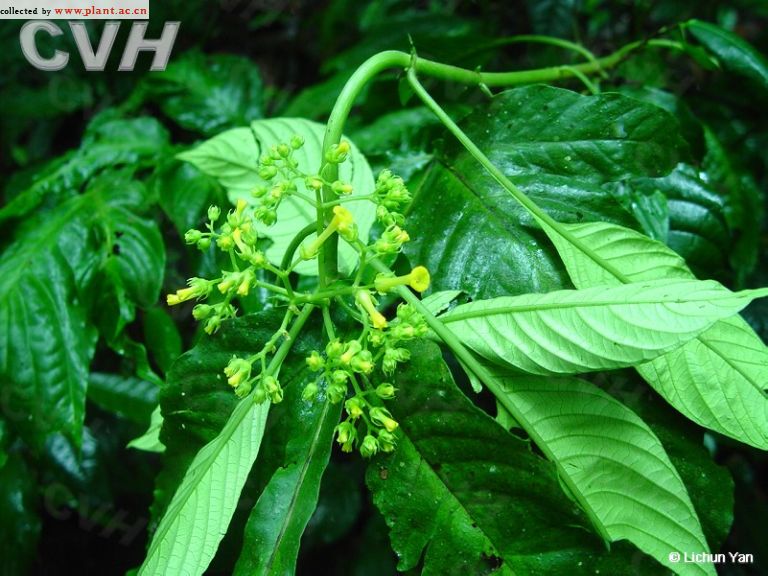长花腺萼木Mycetia longiflora How ex Lo
长花腺萼木Mycetia longiflora How ex Lo
1. 长花腺萼木(中国高等植物图鉴)
Mycetia longiflora How ex Lo in Guihaia 11(2): 107. 1991.
《Flora of China》 Vol. 19 (2011)
Mycetia longiflora F. C. How ex H. S. Lo Guihaia. 11: 107. 1991.
长花腺萼木 chang hua xian e mu
Mycetia longiflora f. howii H. S. Lo.
Shrubs, 0.6-2 m tall; branches puberulent becoming glabrescent. Leaves generally isophyllous; petiole 2-7 cm, densely tomentulose or puberulent; blade drying thinly papery, elliptic-oblong, obovate, or elliptic, 10-25 × 4-10.5 cm, adaxially glabrous or sparsely puberulent along midrib, abaxially glabrous or puberulent to tomentulose along principal veins, base cuneate to acute and often long decurrent, apex acute to acuminate; secondary veins 10-15 pairs; stipules persistent, triangular to ovate, 3-5 mm, puberulent, obtuse, acute, or shortly 2-lobed. Inflorescences terminal, laxly cymose, densely puberulent to tomentulose, many flowered, often deflexed to pendulous; peduncle 0.3-1 cm; branched portion 4-5 × 7-10 cm; bracts reduced or narrowly triangular to lanceolate, 2-5 mm; pedicels 2.5-7 mm. Flowers pedicellate. Calyx densely puberulent, tomentulose, or glabrescent; hypanthium portion subglobose to obconic, 1.5-2.5 mm; limb lobed to base; lobes narrowly triangular to narrowly lanceolate, 4-6.5 mm. Corolla yellow, tubular, densely puberulent to glabrescent outside; tube 14-16 mm, white villous above middle inside or in throat; lobes broadly ovate-triangular, 2-2.5 mm. Berries subglobose, ca. 5 mm in diam., puberulent to glabrescent. Fl. Jul-Aug, fr. Oct-Jan.
● Dense forests; 600-1700 m. Yunnan.
Two forms of this species were separated in the protologue and by H. S. Lo in FRPS (71(1): 315. 1999). Lo distinguished Mycetia longiflora f. howii by its glabrous corollas and glabrous smaller leaves though no measurements were given. Presumably f. longiflora thus comprised plants with pubescent to subglabrous corollas and pubescent, larger leaves. The characters used to distinguish these forms vary continuously within most populations and species of Rubiaceae; accordingly, they are not recognized here.Two forms of this species were separated in the protologue and by H. S. Lo in FRPS (71(1): 315. 1999). Lo distinguished Mycetia longiflora f. howii by its glabrous corollas and glabrous smaller leaves though no measurements were given. Presumably f. longiflora thus comprised plants with pubescent to subglabrous corollas and pubescent, larger leaves. The characters used to distinguish these forms vary continuously within most populations and species of Rubiaceae; accordingly, they are not recognized here.
科名:茜草科 Rubiaceae
属名:腺萼木属 Mycetia

1. 长花腺萼木(中国高等植物图鉴)
Mycetia longiflora How ex Lo in Guihaia 11(2): 107. 1991.
《Flora of China》 Vol. 19 (2011)
Mycetia longiflora F. C. How ex H. S. Lo Guihaia. 11: 107. 1991.
长花腺萼木 chang hua xian e mu
Mycetia longiflora f. howii H. S. Lo.
Shrubs, 0.6-2 m tall; branches puberulent becoming glabrescent. Leaves generally isophyllous; petiole 2-7 cm, densely tomentulose or puberulent; blade drying thinly papery, elliptic-oblong, obovate, or elliptic, 10-25 × 4-10.5 cm, adaxially glabrous or sparsely puberulent along midrib, abaxially glabrous or puberulent to tomentulose along principal veins, base cuneate to acute and often long decurrent, apex acute to acuminate; secondary veins 10-15 pairs; stipules persistent, triangular to ovate, 3-5 mm, puberulent, obtuse, acute, or shortly 2-lobed. Inflorescences terminal, laxly cymose, densely puberulent to tomentulose, many flowered, often deflexed to pendulous; peduncle 0.3-1 cm; branched portion 4-5 × 7-10 cm; bracts reduced or narrowly triangular to lanceolate, 2-5 mm; pedicels 2.5-7 mm. Flowers pedicellate. Calyx densely puberulent, tomentulose, or glabrescent; hypanthium portion subglobose to obconic, 1.5-2.5 mm; limb lobed to base; lobes narrowly triangular to narrowly lanceolate, 4-6.5 mm. Corolla yellow, tubular, densely puberulent to glabrescent outside; tube 14-16 mm, white villous above middle inside or in throat; lobes broadly ovate-triangular, 2-2.5 mm. Berries subglobose, ca. 5 mm in diam., puberulent to glabrescent. Fl. Jul-Aug, fr. Oct-Jan.
● Dense forests; 600-1700 m. Yunnan.
Two forms of this species were separated in the protologue and by H. S. Lo in FRPS (71(1): 315. 1999). Lo distinguished Mycetia longiflora f. howii by its glabrous corollas and glabrous smaller leaves though no measurements were given. Presumably f. longiflora thus comprised plants with pubescent to subglabrous corollas and pubescent, larger leaves. The characters used to distinguish these forms vary continuously within most populations and species of Rubiaceae; accordingly, they are not recognized here.Two forms of this species were separated in the protologue and by H. S. Lo in FRPS (71(1): 315. 1999). Lo distinguished Mycetia longiflora f. howii by its glabrous corollas and glabrous smaller leaves though no measurements were given. Presumably f. longiflora thus comprised plants with pubescent to subglabrous corollas and pubescent, larger leaves. The characters used to distinguish these forms vary continuously within most populations and species of Rubiaceae; accordingly, they are not recognized here.

